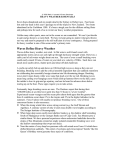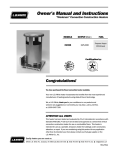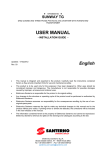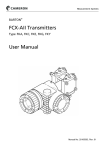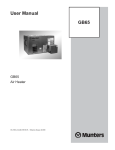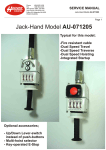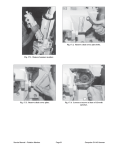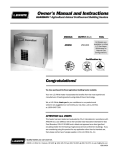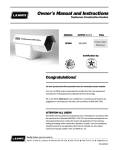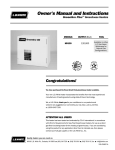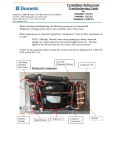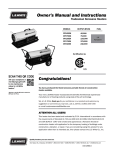Download Norseman 250
Transcript
Owner's Manual and Instructions Norseman Heavy Duty Convection Construction Heaters MODEL OUTPUT (Btuh) FUEL 341 250,000 Propane Gas Vapor Withdrawal Congratulations! You have purchased the finest convection construction heater available. Your new L.B. White heater incorporates the benefits from the most experienced manufacturer of heating products using state-of-the-art technology. We, at L.B. White, thank you for your confidence in our products and welcome any suggestions or comments you may have...call us, toll-free, at (800) 345-7200. ATTENTION ALL USERS This heater has been tested and evaluated by L.B. White Co., Inc as a direct fired convection construction heater intended for use as the temporary heating of buildings under construction, alteration, or repair. The heater shall be used only on noncombustible surfaces. If you are considering using this product for any applications other than its intended use, then please contact your fuel gas supplier or the L.B. White Co., Inc. 150-22268-A GENERAL HAZARD WARNING ■ Failure to comply with the precautions and instructions provided with this heater, can result in: — Death — Serious bodily injury or burns — Property damage or loss from fire or explosion — Asphyxiation due to lack of adequate air supply or carbon monoxide poisoning ■ Read this Owner’s Manual before installing or using this product. ■ Only properly-trained service people should repair or install this heater. ■ Save this Owner’s Manual for future use and reference. ■ Owner’s Manuals and replacement labels are available at no charge. For assistance, contact L.B. White at 800-345-7200. WARNING ■ Proper gas supply pressure must be provided to the inlet of the heater. ■ Refer to data plate for proper gas supply pressure. ■ Gas pressure in excess of the maximum inlet pressure specified at the heater inlet can cause fires or explosions. ■ Fires or explosions can lead to serious injury, death, or building damage. ■ Gas pressure below the minimum inlet pressure specified at the heater inlet may cause improper combustion. ■ Improper combustion can lead to asphyxiation or carbon monoxide poisoning and therefore serious injury or death. WARNING Fire and Explosion Hazard ■ Not for home or recreational vehicle use. ■ Installation of this heater in a home or recreational vehicle may result in a fire or explosion. ■ Fire or explosions can cause property damage or loss of life. FOR YOUR SAFETY If you smell gas: 1. Open windows. 2. Don't touch electrical switches. 3. Extinguish any open flame. 4. Immediately call your gas supplier. FOR YOUR SAFETY Do not store or use gasoline or other flammable vapors and liquids in the vicinity of this or any other appliance. WARNING Fire and Explosion Hazard ■ Keep solid combustibles a safe distance away from the heater. ■ Solid combustibles include wood or paper products, building materials and dust. ■ Do not use the heater in spaces which contain or may contain volatile or airborne combustibles. ■ Volatile or airborne combustibles include gasoline, solvents, paint thinner, dust particles or unknown chemicals. ■ Failure to follow these instructions may result in a fire or explosion. ■ Fire or explosions can lead to property damage, personal injury or loss of life. 2 Table of Contents SECTION PAGE General Information . . . . . . . . . . . . . . . . . . . . . . . . . . . . . . . . . . . . . . . . . . . . . . . . . . . . . . . . . . . . . . . . . . .3 Heater Specifications . . . . . . . . . . . . . . . . . . . . . . . . . . . . . . . . . . . . . . . . . . . . . . . . . . . . . . . . . . . . . . . . . .4 Safety Precautions . . . . . . . . . . . . . . . . . . . . . . . . . . . . . . . . . . . . . . . . . . . . . . . . . . . . . . . . . . . . . . . . . . . .5 Installation Instructions General . . . . . . . . . . . . . . . . . . . . . . . . . . . . . . . . . . . . . . . . . . . . . . . . . . . . . . . . . . . . . . . . . . . . . . . . .7 Burner and Gas Control Assembly . . . . . . . . . . . . . . . . . . . . . . . . . . . . . . . . . . . . . . . . . . . . . . . . . . . .8 Hose and Regulator Assembly . . . . . . . . . . . . . . . . . . . . . . . . . . . . . . . . . . . . . . . . . . . . . . . . . . . . . . .8 Start-Up Instructions . . . . . . . . . . . . . . . . . . . . . . . . . . . . . . . . . . . . . . . . . . . . . . . . . . . . . . . . . . . . . . . . . .9 Shut-Down Instructions . . . . . . . . . . . . . . . . . . . . . . . . . . . . . . . . . . . . . . . . . . . . . . . . . . . . . . . . . . . . . . . .9 Cleaning Instructions . . . . . . . . . . . . . . . . . . . . . . . . . . . . . . . . . . . . . . . . . . . . . . . . . . . . . . . . . . . . . . . . .10 Maintenance Instructions . . . . . . . . . . . . . . . . . . . . . . . . . . . . . . . . . . . . . . . . . . . . . . . . . . . . . . . . . . . . .10 Service Instructions . . . . . . . . . . . . . . . . . . . . . . . . . . . . . . . . . . . . . . . . . . . . . . . . . . . . . . . . . . . . . . . . . .11 Gas Pressure Checks . . . . . . . . . . . . . . . . . . . . . . . . . . . . . . . . . . . . . . . . . . . . . . . . . . . . . . . . . . . . . . . .12 Troubleshooting Information . . . . . . . . . . . . . . . . . . . . . . . . . . . . . . . . . . . . . . . . . . . . . . . . . . . . . . . . . . .13 Heater Component Function . . . . . . . . . . . . . . . . . . . . . . . . . . . . . . . . . . . . . . . . . . . . . . . . . . . . . . . . . . .14 Parts Identification Parts Schematic . . . . . . . . . . . . . . . . . . . . . . . . . . . . . . . . . . . . . . . . . . . . . . . . . . . . . . . . . . . . . . . . .15 Parts List . . . . . . . . . . . . . . . . . . . . . . . . . . . . . . . . . . . . . . . . . . . . . . . . . . . . . . . . . . . . . . . . . . . . . . .16 Warranty Policy . . . . . . . . . . . . . . . . . . . . . . . . . . . . . . . . . . . . . . . . . . . . . . . . . . . . . . . . . . . . . . . . . . . . . .17 Replacement Parts and Service . . . . . . . . . . . . . . . . . . . . . . . . . . . . . . . . . . . . . . . . . . . . . . . . . . . . . . . .17 General Information This Owner's Manual includes all options and accessories commonly used on this heater. When calling for technical service assistance, or for other specific information, always have model number, configuration number and serial number available. This information is contained on the dataplate. This manual will instruct you in the operation and care of your heater. Have your qualified installer review this manual with you so that you fully understand the heater and how it functions. 3 The gas supply line installation, installation of the heater, and repair and servicing of the heater requires continuing expert training and knowledge of gas heaters and should not be attempted by anyone who is not so qualified. See page 6 for definition of the necessary qualifications. Contact your local L.B. White distributor or the L.B. White Co., Inc. for assistance, or if you have any questions about the use of the equipment or its application. The L.B. White Co., Inc. has a policy of continuous product improvement. It reserves the right to change specifications and design without notice. Heater Specifications Model 341 SPECIFICATIONS Propane Gas Fuel Type Maximum Input (BTUH) 250,000 Ventilation Air Required to Support Combustion Inlet Gas Supply Pressure Acceptable at the Inlet of the Pilot Safety Control Valve 1041 CFM MAX. 23 PSIG. MIN. 23 PSIG. 11.6 lbs. Fuel Consumption Per Hour Dimensions (Inches) LxWxH Minimum Safe Distances From Nearest Combustible Materials Not for use on combustible materials Net Weight (lbs.) Shipping Weight (lbs.) 18 x 13 x 24 TOP TO CEILING SIDES FUEL CONTAINER 8 ft. 4 ft. 6 ft. (1.83 m) 30 34 4 Safety Precautions WARNING ■ ■ ■ ■ ■ Asphyxiation Hazard Do not use this heater for heating human living Owner’s Manual, heater dataplate, or contact the L.B. quarters. White Company to determine combustion air ventilation requirements of the heater. Do not use in unventilated areas. ■ Lack of proper ventilation air will lead to improper The flow of combustion and ventilation air must not be combustion. obstructed. ■ Improper combustion can lead to carbon monoxide Proper ventilation air must be provided to support the poisoning leading to serious injury or death. Symptoms combustion air requirements of the heater being used. of carbon monoxide poisoning can include headaches, dizziness and difficulty in breathing. Refer to the specification section of the heater’s FUEL GAS ODOR Propane gas and natural gas have man-m made odorants added specifically for detection of fuel gas leaks. If a gas leak occurs, you should be able to smell the fuel gas. THAT’S YOUR SIGNAL TO GO INTO IMMEDIATE ACTION! ■ Do not take any action that could ignite the fuel gas. Do not operate any electrical switches. Do not pull any power supply or extension cords. Do not light matches or any other source of flame. Do not use your telephone. ■ Get everyone out of the building and away from the area immediately. ■ Close all propane gas tank or cylinder fuel supply valves, or the main fuel supply valve located at the meter if you use natural gas. ■ Propane gas is heavier than air and may settle in low areas. When you have reason to suspect a propane leak, keep out of all low areas. ■ Use your neighbor’s phone and call your fuel gas supplier and your fire department. Do not re-enter the building or area. ■ Stay out of the building and away from the area until declared safe by the firefighters and your fuel gas supplier. ■ FINALLY, let the fuel gas service person and the firefighters check for escaped gas. Have them air out the building and area before you return. Properly trained service people must repair the leak, check for further leakages, and then relight the appliance for you. ODOR FADING -- NO ODOR DETECTED ■ Some people cannot smell well. Some people cannot smell the odor of the man-m made chemical added to propane or natural gas. You must determine if you can smell the odorant in these fuel gases. ■ Learn to recognize the odor of propane gas and natural gas. Local propane gas dealers will be more than happy to give you a scratch and sniff pamphlet. Use it to become familiar with the fuel gas odor. ■ Smoking can decrease your ability to smell. Being around an odor for a period of time can affect your sensitivity to that particular odor. ■ The odorant in propane gas and natural gas is colorless and t he i ntensity o f i ts o dor c an f ade u nder s ome circumstances. ■ If there is an underground leak, the movement of gas through the soil can filter the odorant. ■ Propane gas odor may differ in intensity at different levels. Since propane gas is heavier than air, there may be more odor at lower levels. ■ Always be sensitive to the slightest gas odor. If you continue to detect any gas odor, no matter how small, treat it as a serious leak. Immediately go into action as discussed previously. ATTENTION -- CRITICAL POINTS TO REMEMBER! ■ Propane gas has a distinctive odor. Learn to recognize these odors. (Reference Fuel Gas Odor and Odor Fading sections above. ■ Even if you are not properly trained in the service and repair of the heater, ALWAYS be consciously aware of the odors of propane gas and natural gas. ■ If you have not been properly trained in repair and service of propane gas then do not attempt to light heater, perform service or repairs, or make any adjustments to the heater on the propane gas fuel system. ■ A periodic sniff test around the heater or at the heater’s joints; i.e. hose, connections, etc., is a good safety practice under any conditions. If you smell even a small amount of gas, CONTACT YOUR FUEL GAS SUPPLIER IMMEDIATELY. DO NOT WAIT! 5 WARNING Fire Hazard ■ Temperatures at base of this heater may ignite ■ combustible materials Use the heater on non-combustible materials to avoid a fire hazard. ATTENTION ■ This heater is not suitable for use on any wooden floors (plywood, particle board, pressboard, etc.) and shall not be set up on these nor any other combustible materials. ■ If the heater is used on a combustible floor the heater shall rest on a suitable heat insulating material such as concrete of at least 1 inch thickness or equivalent. The insulating material shall extend beyond the heater 2 feet or more in all directions. 1. Do not attempt to install, repair, or service this heater or the gas supply line unless you have continuing expert training and knowledge of gas heaters. Qualifications for service and installation of this equipment are as follows: a. To be a qualified gas heater service person, you must have sufficient training and experience to handle all aspects of gas-fired heater installation, service and repair. This includes the task of installation, troubleshooting, replacement of defective parts and testing of the heater. You must be able to place the heater into a continuing safe and normal operating condition. You must completely familiarize yourself with each model heater by reading and complying with the safety instructions, labels, Owner’s Manual, etc., that is provided with each heater. b. To be a qualified gas installation person, you must have sufficient training and experience to handle all aspects of installing, repairing and altering gas lines, including selecting and installing the proper equipment, and selecting proper pipe and tank size to be used. This must be done in accordance with all local, state and national codes as well as the manufacturer’s requirements. 2. All installations and applications of L.B. White heaters must meet all relevant local, state and national codes. Included are propane gas, natural gas, electrical, and safety codes. Your local fuel gas supplier, a local licensed electrician, the local fire department or similar government agencies, or your insurance agent can help you determine code requirements. 3. We cannot anticipate every use which maybe made of our heaters. Check with the local fire safety authority if you have questions about applications. 4. The heater shall be installed so that it is not directly exposed to water spray, rain, or dripping water. 5. Do not locate fuel gas containers or fuel supply hoses anywhere near the discharge outlet of the heater. 6. Do not block air intakes or discharge outlets of the heater. Doing so may cause improper combustion or damage to heater components leading to property damage. 7. The hose assembly shall be visually inspected on a daily basis, after heater relocation, and when the heater is in use. If it is evident there is excessive abrasion or wear, or if the hose is cut, it must be replaced prior to the heater being put into operation. The hose assembly shall be protected from building materials, and contact with hot surfaces during use. The hose assembly shall be that specified by the manufacturer. See parts list. 8. Check for gas leaks and proper function upon heater installation, when relocating, and after servicing. Refer to leak check instructions within installation section of this manual. 9. This heater should be inspected for proper operation by a qualified service person before each use and at least annually. 10. Always turn off the gas supply to the heater if the heater is not going to be used in the heating of the work space. 11. If gas flow is interrupted and flame goes out, do not relight the heater until you are sure that all gas that may have accummulated has cleared away. In any event, do not relight the heater for at least 5 minutes. 12. Minimum propane gas supply cylinder size to be used shall be 100 pounds when using a cylinder supply system. The system must be arranged to provide vapor withdrawal from the operating cylinder. 13. When the heater is to be stored indoors, the connection between the propane gas supply cylinder(s) and the heater must be disconnected and the cylinder(s) removed form the heater and stored in accordance with Chapter 5 if the Standard for the Storage and Handling of Liquified Petroleum Gases, ANSI/NFPA 58. 14. Propane gas supply containers have left handed threads. Always use the appropriate wrench to make a connection to tighten or loosen the P.O.L. fitting at the cylinders’ gas supply valve. -- ANSI/NFPA 58, latest edition, Standard for Storage and Handling of Liquefied Petroleum Gas and/or -- ANSI Z223.1/NFPA 54, National Fuel Gas Code 6 Installation Instructions GENERAL 1. Read all safety precautions and follow L. B. White recommendations when installing this heater. If during the installation or relocating of heater, you suspect that a part is damaged or defective, call a qualified service agency for repair or replacement. 2. Make sure the heater is properly installed before use. Observe and obey all minimum safe distances of the heater to the nearest combustible materials. Safe distances are given on the heater dataplate and on page 4 of this manual. 3. The heater is approved for indoor use only. 4. The heater shall not be used with ductwork. 5. The heater’s gas pressure regulator (with pressure relief valve) must be protected from adverse weather conditions (rain, ice, snow) as well as from building materials (tar, concrete, plaster, etc.) which can affect safe operation and could result in property damage or injury. 6. Heaters used in the vicinity of combustible tarpaulins, canvas, plastics, wind barriers, or similar coverings shall be located at least 10 feet from the coverings. The coverings shall be securely fastened to prevent ignition or upsetting of the heater due to wind action on the covering or other material. WARNING Fire and Explosion Hazard ■ Do not use open flame (matches, torches, candles, ■ ■ ■ 7. etc.) in checking for gas leaks. Use only approved leak detectors. Failure to follow this warning can lead to fires or explosions. Fires or explosions can lead to property damage, personal injury or loss of life. Check all connections for gas leaks using approved gas leak detectors. Gas leak testing is performed as follows: -- Check all pipe connections, hose connections, fittings and adapters upstream of the gas control with approved gas leak detectors. -- In the event a gas leak is detected, check the components involved for cleanliness and proper application of pipe compound before further tightening. -- Furthermore tighten the gas connections as necessary to stop the leak. 7 -- After all connections are checked and any leaks are stopped, turn on the main burner. -- Stand clear while the main burner ignites to prevent injury caused from hidden leaks that could cause flashback. -- With the main burner in operation, check all connections, hose connections, fittings and joints as well as the gas control valve inlet and outlet connections with approved gas leak detectors. -- If a leak is detected, check the components involved for cleanliness in the thread areas and proper application of pipe compound before further tightening. -- Tighten the gas connection as necessary to stop the leak. -- If necessary, replace the parts or components involved if the leak cannot be stopped. -- Ensure all gas leaks have been identified and repaired before proceeding. 8. A qualified service agency must check for proper operating gas pressure upon installation of the heater. 9. Light according to instructions on heater or within owner's manual. 10. Make sure the heater has the proper gas regulator for the application. A regulator must be connected to the gas supply so that gas pressure at the inlet to the gas valve is regulated within the range specified on the dataplate at all times. Contact your gas supplier, or the L.B. White Co., Inc. if you have any questions. 11. This heater is configured for use for propane gas vapor withdrawal only. Do not use the heater in an propane gas liquid withdrawal system or application. If you are in doubt, contact the L.B. White Co., Inc. 12. Take time to understand how to operate and maintain the heater by using this Owner’s Manual. Make sure you know how to shut off the gas supply to the building and also to the individual heater. Contact your fuel gas supplier if you have any questions. 13. Any defects found in performing any of the service or maintenance procedures must be eliminated and defective parts replaced immediately. The heater must be retested by properly qualified service personnel before placing the heater back into use. BURNER AND GAS CONTROL ASSEMBLY 1. Remove hex bolt from underside of burner. See Fig. 1. FIG. 1 2. Position pre-assembled burner and gas control into case assembly of heater: a. Burner head is located between tabs in base. b. Burner mounting hole in base aligns with tapped hole in burner casting. TABS 3. Fasten burner to base using bolt removed in step 1. Tighten securely. 1/4" DIA HOLE MOUNTING HOLE BURNER MOUNTING BOLT HOSE AND REGULATOR ASSEMBLY 1. Always use approved pipe thread compound suitable for use with L.P. gas or natural gas on the threaded connections. 2. Assemble the components together according to Fig. 2. This view is to show general assembly of the components only. 3. Tighten all connections securely. 4. Check all connections for gas leaks using approved gas leak detectors. FIG. 2 PROPANE GAS SUPPLY CONTAINER VALVE REGULATOR HOSE R TE EA H TO 8 Start-Up Instructions WARNING 3. Keep the pilot button depressed for about 30 seconds to allow the thermocouple to warm up. 4. To ignite the main burner fully open the manual main burner valve located between the pilot safety control and burner. Fire or Explosion Hazard ■ Use only your hand to depress the gas control button. Never use any tools. ■ If the button will not depress by normal hand pressure, the control should be replaced by a qualified service person. ■ Force or attempted repair may result in a fire or explosion causing property damage, severe injury, or death. 1. Slowly open the propane gas supply container valve. 2. Fully depress the button on the pilot safety control valve while applying flame to the pilot. FIG. 3 ATTENTION ■ On new installations it may take a short time for gas to purge out any air in the pilot line and hose before the pilot lights. MANUAL MAIN BURNER VALVE PILOT BUTTON Shut-Down Instructions A. To properly shut heater down after normal use, or when further use is anticipated: -- Close manual main burner valve on heater. B. To properly shut heater down for storage, or when further use is not anticipated: 1. Close propane gas supply container valve. Allow heater to burn off remaining gas in its hose. 2. Close manual main burner valve on heater. 3. Disconnect the heater from its gas supply. 9 Cleaning Instructions WARNING Fire, Burn, and Explosion Hazard ■ This heater contains components used in the gas management, and safety systems. ■ Such components may become inoperative or fail due to dust, dirt, wear and aging. ■ Periodic cleaning and inspection as well as proper maintenance are essential to avoid serious injury or property damage. 1. Before cleaning, shut off all gas supply valves. 2. The heater should have dir t or dust removed periodically: a. Before each use give the heater a general cleaning using compressed air or a soft brush or dry rag on its case and internal components. b. At least once a year, give the heater a thorough cleaning. At this time, remove the burner assembly and clean the burner and its related components. WARNING Do not use a pressure washer, water, or liquid cleaning solution on any gas controls. Use of a pressure washer, water, or liquid cleaning solution on the control components can cause severe personal injur y or property damage due to water and/or liquids: * On gas control valves causing corrosion which can result in gas leaks and fire or explosion from the leak. Clean all components of the heater with pressurized air, a dry brush or a dry cloth. Maintenance Instructions 1. The area surrounding the heater shall be kept clear and free from combustible materials, gasoline, and other flammable vapors and liquids. 2. Have your gas supplier check all gas piping annually for leaks or restrictions in gas lines. 3. Regulators must be periodically inspected to make sure the regulator vents are not blocked. Debris, insects, insect nests, snow, or ice on a regulator can block vents and cause excess pressure at the appliance. 4. Regulators can wear out and function improperly. Have your gas supplier check the date codes on all regulators installed and check delivery pressures to the heater to make sure that the regulator is reliable. 5. Review all heater markings (warnings, start-up, shutdown, etc.) at the time of maintenance for legibility. Make sure none are cut, torn, or otherwise damaged. Any damaged markings must be replaced immediately by contacting the L.B. White Co., Inc. Dataplates, start-up and shut-down instructions and warnings are available at no cost. 10 Service Instructions A. General FIG. 4 WARNING Burn Hazard ■ Heater surfaces are hot for a period of time after shutdown. ■ Allow heater to cool before servicing. ■ Failure to follow this warning can result in burns. WARNING Fire and Explosion Hazard ■ Do not disassemble or attempt to repair any heater FIG. 5 component, including gas hose and regulators. BURNER ORIFICE ■ All components must be replaced if defects are found. ■ Failure to follow this warning will result in fire or explosions leading to property damage, serious injury, or death. 1. Close fuel supply valves to heater and allow heater to burn off remaining fuel in its hose before servicing, unless it is necessary to have the valves open for the service procedure. 2. Clean the heater’s orifices with compressed air or a soft rag. Do not use files, drills, broaches, etc. to clean the orifice hole. Doing so will enlarge the hole, causing ignition or combustion problems. Replace the orifice if it cannot be cleaned properly. 3. Reverse the respective ser vice procedure to reassemble. Ensure gas connections are tightened securely. 4. After repair, light the heater. Check for proper operation and for gas leaks. B. Initial Preparation 1. Remove burner retaining bolt from heater base. 2. Remove burner assembly from case. ELBOW BURNER VALVE VALVE D. Pilot Orifice 1. Loosen compression nut at pilot orifice and carefully reposition pilot tube away from the orifice. See Fig. 6. 2. Remove pilot orifice from pilot head and screen from orifice inlet. 3. Ensure orifice hole is not plugged. E. Thermocouple 1. Loosen attachment nut at pilot assembly and connector nut at safety control valve. Remove thermocouple. See Fig. 6. 2. At reassembly, avoid sharp bends or kinks in thermocouple to prevent damage. FIG. 6 PILOT HEAD C. Burner Orifice Removal BRACKET ASSEMBLY 1. Disconnect compression nut from brass elbow and thermocouple from pilot control valve. See Fig. 4. 2. Carefully reposition pilot line and thermocouple away from safety control valve. 3. Disassemble the following: See Fig. 5. -- Pilot control with manual valve from burner orifice -- Burner orifice from burner casting 4. Clean the burner orifice. 11 ATTACHMENT NUT THERMOCOUPLE CONNECTOR NUT PILOT ORIFICE SCREEN NUT BURNER ORIFICE Gas Pressure Checks ATTENTION FIG. 7 HIGH PRESSURE GAUGE This procedure is to be done once a year prior to the heating season, anytime the heater is moved from one job location to the next, or after servicing the heater. MATERIALS REQUIRED (To be secured through local purchase) Quantity 1 Description High Pressure Gas Gauge capable of reading up to 35 PSIG 1 1/4 in. Tee 1 1/4 in. Nipple A. PREPARATION 1. Close fuel supply valve at gas supply container. 2. Allow heater to burn off gas remaining in it’s gas supply line. 3. Close manual main burner valve on heater and remove gas hose from heater. 4. Remove hose adapter from inlet of pilot safety control valve. B. GAUGE INSTALLATION 1. Connect the following materials together in the order as given and tighten securely. See Fig. 7 -- Tee to inlet of pilot safety control. -- Nipple to tee. -- Hose adapter (as removed earlier) to nipple. -- Gas hose to hose adapter. 2. Connect gauge to tee. PILOT CONTROL VALVE NIPPLE TEE HOSE ADAPTER (FROM PILOT VALVE INLET) HOSE C. READING PRESSURES 1. Start the heater. With the heater operating, the pressure gauge should read the pressure specified on the dataplate or in the specification section of this owner’s manual. 2. Does the pressure reading at the inlet of the safety control agree with that given on the dataplate? If so, no fur ther checking or adjustment is required. Proceed to section D. 3. If the inlet pressures do not agree with that specified on the dataplate, then check the following: -- Improper regulator for heater. -- Regulator out of adjustment. (Replace if necessary). -- Blockage in gas hose. -- Insufficient size or quantity of propane gas supply containers. D. COMPLETION 1. Once the proper inlet pressure has been confirmed, close fuel supply valves. 2. Allow heater to burn off fuel remaining in gas supply line. 3. Remove gauge, hose adapter, nipple and tee. 4. Reconnect hose adapter to inlet of safety control valve and hose to hose adapter. 5. Tighten all connections securely and check for gas leaks. 12 Troubleshooting Information PROBLEMS 1. Pilot will not light. CAUSES REMEDIES * Fuel supply valves closed. * Open fuel supply valves. * Pilot button not fully depressed. * Depress pilot button completely. * Pilot orifice is plugged. * Clean or replace pilot orifice. (DO NOT insert sharp instruments in orifice holes, blow out with compressed air.) * Screen at inlet of pilot orifice is plugged. * Remove screen and clean or replace screen. * Restriction in gas hose or pilot line. * Remove hose or pilot line from heater and blow out with compressed air or replace if necessary. * Air in gas line. * Push in pilot button (normally 30 seconds is sufficient) on pilot valve to purge air from line (usually necessary at time of installation). * Pilot safety gas control is defective * Replace entire pilot safety control valve. * Restriction in gas hose or pilot line. * See remedy for same cause in Problem #1. * Insufficient time allowed for pilot light to heat up thermocouple. * Hold in pilot button for 30 seconds to allow proper warm up. * Loose thermocouple. * Tighten thermocouple at gas control and at pilot bracket. * Defective thermocouple. * Replace thermocouple. * Pilot orifice is plugged. * See remedy for same in Problem #1. * Defective pilot safety control valve. * Replace entire pilot safety control valve. * Improper gas pressure. * Set pressure according to pressure on dataplate. * Main burner valve closed on heater. * Open all valves. * Pilot light not lit. * Light the pilot. * Burner orifice plugged. * Clean the burner orifice. 4. Burner flame lifting off burner. * Fuel pressure set too high. * Set pressure according to pressure on dataplate. * Blockages in burner orifice or at primary air inlets of burner. * Clean suspected area with soft brush, dry cloth, or compressed air. 5. Heater does not seem to be delivering maximum heat output. * Gas supply valves not fully open. * Open valves completely. * Burner orifice plugged. * Clean burner orifice with compressed air or replace. * Low fuel supply pressure. * Consult propane gas supplier. Cylinder or tank needs replacement or refill. Regulator needs adjustment. Check for use of proper regulation and fuel gas. 2. Pilot lights but will not stay lit when pilot button is released. 3. Main burner will not light. 13 Heater Component Function Burner Cast iron component used to channel gas and provide an area at which the fuel may ignite. Pilot Tube Formed copper tube used to convey gas from the safety control valve to the pilot light orifice. Burner Orifice Brass metering device used to feed gas to burner at a specific rate. Regulator The heart of any gas supply installation. Used to deliver a working pressure to the heater under varying conditions in tank pressure. Gas Hose Flexible connector used to convey gas from supply line in building to heater. Pilot Light Orifice A metering device used to supply gas for the dual purpose of igniting the main burner and heating the thermocouple. Thermocouple A thermoelectric device that converts heat energy directly into electrical energy. Works in conjunction with the electromagnet in the gas control valve thereby providing gas supply for the pilot light. Pilot Safety Control Valve A gas control valve which is held open by electrical power supplied by a pilot generator and which closes automatically to shut off the flow of gas to the main burner when the pilot flame is extinguished or becomes too small to light the main burner. 14 Parts Identification PARTS SCHEMATIC 17 18 16 15 9 8 6 14 13 7 12 5 11 10 4 3 19 2 1 15 PARTS LIST Item 1 2 3 4 5 6 7 8 9 10 11 12 13 14 15 16 17 18 19 Description Regulator Adapter, Hose Hose, 1/4 in. x 10 ft. Adapter, Hose Valve, Pilot Safety Ell w/nut and Sleeve Valve, Manual Burner Thermocouple Orifice Burner Tube, Pilot w/Nuts & Sleeves Nut and Sleeve Screen Orifice, Pilot w/ Screen Screw Bracket, Pilot Head, Pilot Burner, Casting Case, Assembly w/Labels Bolt, 1/4-20 x 1/2 Part Number 550-21788 310-01098 400-20242 310-07970 130-07966 130-07968 130-20229 120-01090 310-01329 550-20529 550-01168 130-01722 400-01230 130-01213 400-03202 400-01079 320-03989 500-22338 130-01151 16 Warranty Policy EQUIPMENT L.B. White Co., Inc. warrants that the component parts of its heater are free from defects in material and workmanship, when properly installed, operated, and maintained in accordance with the Owner’s Manual safety guides and labels contained with each unit. If, within 12 months from the date of purchase by the end user, any component is found to be defective, L.B. White Co., Inc. will at its option, repair or replace the defective part or heater, with a new par t or heater, F.O.B., Onalaska, Wisconsin. A warranty card on file at L.B. White will automatically qualify the heater and its component parts for warranty consideration. If a warranty card is not on file, a copy of the bill of sale will be required to establish warranty qualification. If neither is available, the warranty period will be 12 months from date of shipment from L B. White. PARTS L.B. White Co., Inc. warrants that replacement parts purchased from the company and used on the appropriate L. B. White heater are free from defects both in material and workmanship for 12 months from the date of purchase by the end user. Warranty is automatic if a component is found defective within 12 months of the date code marked on the part. If the defect occurs more than 12 months later than the date code but within 12 months from the date of purchase by the end user, a copy of a bill of sale will be required to establish warranty qualification. The warranty set forth above is the exclusive warranty provided by L.B. White, and all other warranties, including any implied warranties or merchantability or fitness for a particular purpose, are expressly disclaimed. In the event any implied warranty is not hereby effectively disclaimed due to operation of law, such implied warranty is limited in Replacement Parts and Service Contact your local L.B. White dealer for replacement parts and service or call the L.B. White Co., Inc. at (800) 3457200 for assistance. Be sure that you have your heater model number and configuration number when calling. 17 duration to the duration of the applicable warranty stated above. The remedies set forth above are the sole and exclusive remedies available hereunder. L.B. White will not be liable for any incidental or consequential damages directly or indirectly related to the sale, handling or use of the heater, and in any event L.B. White's liability in connection with the heater, including for claims based on negligence or strict liability, is limited to the purchase price. Some states do not allow limitations on how long an implied warranty lasts, so the above limitation may not apply to you. Some states do not allow the exclusion or limitation of incidental or consequential damages, so the above limitation or exclusion may not apply to you. This warranty gives you specific legal rights, and you may also have other rights which vary from state to state.




















